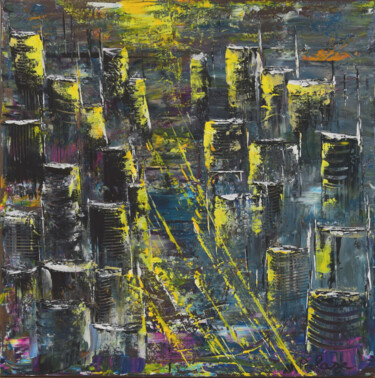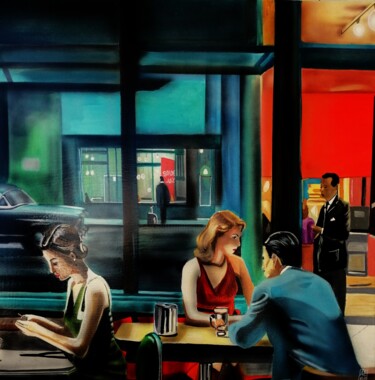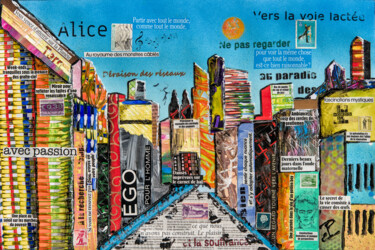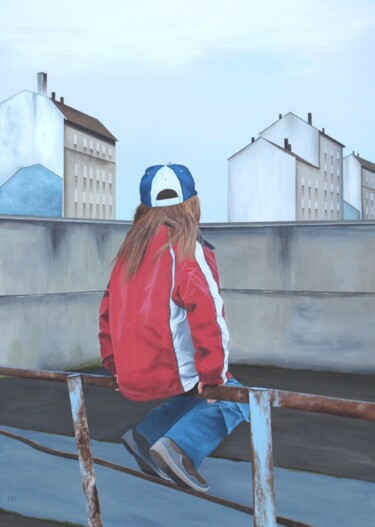853 판매용 원본 그림:
아크릴 기술의 기원은 무엇입니까?
Acrylic paints use traditional pigments mixed with synthetic resins. The use of acrylic paint in Art developed from the second half of the twentieth century, popularized by artists like Willem de Kooning, Kenneth Noland or Mark Rothko who were the first to use this material in their canvases. Composed of pigments of natural or artificial origin based on resins and binders composed of polymers, acrylic paint is particularly appreciated by contemporary artists because of its characteristics: easy to dilute, to apply, painless, resistant and durable. Unlike oil paint, acrylic paint dries quickly and allows for many effects of shine and texture effects in the painterly works of artists. This explains why acrylic paints are probably the most commonly used today.
조형 미술 스타일를 어떻게 정의하나요?
Figurative art is an artistic style that results in the representation of the visible. He is often opposed to abstract art. Figurative art in painting testifies to a desire to restore all the details of a subject or a situation in its composition (naturalism). The most famous figurative genres are landscapes, portraits and still lifes. Not being an artistic movement but a simple timeless artistic style, it is present in all eras: from the Renaissance to Street Art, including romanticism, realism, hyperrealism, expressionism, symbolism , cubism, fauvism or even impressionism.
"도시" 주제의 작품 구매
Full of life, freedom and opportunities of all kinds, the city represents the place of all possibilities for artists who like to portray its various attractions in their works. Scenes of city life or urban landscapes, the city offers painters a constant source of inspiration. Represent the frenzy of rush hour, the conviviality of the café terraces on Sundays, the calm of the squares and streets still deserted in the early morning… These are all representations that can be found in city paintings. The paintings that have best sketched the city are Boulevard Montmartre with Camille Pissarro, or Nighthawks by Edward Hopper.
판매용 원본 그림을(를) 찾고 계십니까?
현대 회화, 거리 예술, 추상 예술, 구상 예술, 풍경, 초상화, 정물, 누드, 수채화, 유화, 아크릴 페인팅 등 모든 스타일과 모든 회화 기법을 탐색합니다. 200만 개 이상의 현대 미술 작품을 발견하거나 획득할 수 있는 20년 동안 당신의 편입니다! 현대 회화의 관점에서 세계 참조. 전 세계의 현대 작가들의 작품을 찾아 품격 있는 인테리어를 완성해보세요! 단순한 예술 애호가 또는 확인된 수집가? 장식을 진정으로 향상시킬 좋아하는 캔버스 또는 그림을 찾으십시오. Artmajeur는 세계 최고의 현대 예술가들의 독창적인 작품, 한정판 및 예술 판화를 제공합니다. Artmajeur에서 그림은 예술 시장 애호가와 전문가에 의해 선택됩니다. 최신 유행의 수상 경력에 빛나는 유명 화가와 현대 미술 분야의 새로운 떠오르는 스타의 원본 작품을 선택하여 온라인으로 그림을 구매하는 과정을 안내하고 도와드립니다.
아크릴 아트 페인팅을 온라인으로 구매하는 방법은 무엇입니까?
처음으로 아크릴 그림을 온라인으로 구매하는 것은 선택할 수 있는 음영, 버전 및 유형이 너무 많기 때문에 때때로 어려운 작업이 될 수 있습니다. 매우 시각적인 사람의 경우 이는 종종 압도적일 수 있으며 실제로 올바른 구매 결정을 내리고 있는지 여부를 알기 어려운 경우가 많습니다. 이 기사는 당신이 물어야 할 몇 가지 핵심 질문과 구매하기 전에 고려해야 할 몇 가지 사항을 안내할 것입니다.
온라인 쇼핑은 대부분의 사람들에게 표준이 되었습니다. 우리 모두는 커피 한 잔을 홀짝이며 소파에서 무엇이든 살 수 있는 편리함을 좋아합니다. 하지만 특정한 것을 원할 때는 어떻습니까? 정말 아크릴 그림을 사고 싶은데 어디서부터 시작해야 할지 모르겠다면 어떻게 하시겠습니까? 그것이 우리가 들어오는 곳입니다! 온라인 스토어 artmajeur.com에서 사이즈나 스타일로 검색하여 완벽한 제품을 찾을 수 있습니다. 그리고 전 세계적으로 무료 배송이 가능하기 때문에 특별한 선물을 다른 사람의 우편함에 직접 보내는 것이 그 어느 때보다 쉬워졌습니다!
그림의 틀을 잡거나 단순히 늘어서 벽에 걸 계획입니까? 캔버스 작품을 전시할 계획이라면 작품의 크기와 틀의 치수가 적합한지 확인해야 합니다.
어떤 종류의 아크릴 그림을 벽에 표시하고 싶습니까?
생생한 색상의 보다 현대적인 모습 또는 부드러운 색상의 보다 전통적인 모습에 관심이 있으십니까?
이것들은 모두 훌륭한 질문이며 선택의 폭을 좁히고 결정을 더 쉽게 만드는 데 도움이 될 수 있습니다.
다음 중에서 선택할 수 있습니다.
- 아크릴 물감
- 유성 페인트
- 물감
- 다른 많은 유형의 매체와 각각 고유한 특성과 특성이 있습니다.
사용하려는 캔버스 유형을 알았으므로 이제 벽 예술 작품 구매의 다음 측면으로 넘어갈 수 있습니다. 이 다음 부분은 매우 중요하며 아크릴 캔버스와 관련하여 찢어지지 않도록 해야 합니다. 아크릴 페인팅은 아크릴 구아슈가 내구성이 있는 매체이며 손상에 저항할 수 있도록 특정 공식으로 만들어집니다. 즉, 그림이 손상되더라도 쉽게 복구할 수 있습니다.
아크릴 그림을 살 준비가 되셨습니까?
당신은 artmajeur.com의 올바른 위치에 있습니다. 우리는 다양한 아크릴 그림을 판매하고 있으며, 원본 현대 추상화이든 순수 예술 인쇄물이든 상관없이 필요한 것을 찾도록 도울 준비가 되어 있습니다. 귀하의 요구 사항에 대해 문의하십시오!
집 장식에 독특한 트위스트를 추가하려면 온라인으로 아크릴 그림을 구입하십시오. 구매 비용을 조금이라도 절약하고 싶다면 먼저 쇼핑을 해서 절대 최고의 가격을 받고 있다는 것을 알 수 있도록 하십시오. 다양한 웹사이트 정책을 확인해야 합니다.
Artmajeur에서는 인벤토리에 있는 전 세계 예술가들의 수천 점의 그림 중에서 온라인으로 아크릴 그림을 구입할 수 있습니다. 추상 예술, 조경 예술 또는 도시 경관 예술 작품을 찾고 있든 상관없이 저희가 모두 갖추고 있습니다! 우리 아티스트에는 오늘날 시장에 나와 있는 전문 아티스트와 신흥 아티스트가 포함됩니다! 지금 컬렉션을 둘러보고 결과를 필터링하여 자신에게 또는 선물로 완벽한 그림을 찾으십시오!
그림을 온라인으로 구매하는 것은 까다로울 수 있습니다. 그림이 어떤 모습일지, 아니면 마음에 들어할지 모를 수도 있습니다.
그래서 우리는 무료 배송과 손쉬운 반품과 함께 저렴한 가격에 고품질 그림을 제공하기 위해 이 웹사이트를 만들었습니다. 우리는 또한 당신이 우리에게서 구매에 대해 걱정할 필요가 없도록 100% 만족 보장을 제공합니다. 어떤 이유에서든 구매가 만족스럽지 않은 경우 30일 이내에 반품하기만 하면 전액을 환불해 드립니다!
저렴한 가격에 아름다운 예술 작품을 찾고 있다면 아크릴 그림을 확인하십시오. 귀하의 필요에 맞는 작업이나 스타일의 모든 크기를 찾을 수 있습니다. 온라인에서 원본 그림을 가장 좋은 가격으로 제공한다는 것을 알게 될 것입니다!
아크릴 그림을 온라인으로 구매하려는 경우 웹사이트가 평판이 좋은지 확인하십시오. 또한 주문에 지정된 포장에 대한 배송 비용이 구매에 포함되는지 여부, 사용자 정의 수수료는 구매자가 지불해야 하는지 여부를 아는 것도 중요합니다. 이 안내서가 귀하에게 적합한 아크릴 그림에 대한 정보에 입각한 결정을 내리는 데 도움이 되었기를 바랍니다!
Discover contemporary artworks on Artmajeur
Contemporary art is a vibrant constellation of artistic expressions. This creative universe encompasses a wide array of mediums, from paintings, sculpture, and photography to drawing, printmaking, textile art, and digital art, each medium a star shining with its own distinct radiance. Artists use diverse supports and materials to bring their visions to life, such as canvas, wood, metal, and even innovative digital canvases for the creation of virtual masterpieces.
A contemporary painting, for instance, may weave its story through the masterful strokes of acrylic or oil, while a contemporary sculpture might sing its song in the language of stone, bronze, or found objects. The photographic arts capture and manipulate light to produce striking images, while printmaking employs techniques like lithography and screen-printing to produce multiples of a single, impactful image. Textile art plays with fabrics and fibers, whereas digital art pushes the boundaries of creation with innovative technology.
The allure of contemporary art lies in its boundary-pushing nature, its relentless quest for experimentation and its constant reflection of the evolving human experience. This boundless creativity, coupled with its strong social and personal commentary, makes every piece of contemporary art a unique emblem of its time, a mirror held up to the realities and dreams of our complex world. It whispers to us, moves us, provokes thought, and kindles a deep emotional response, stirring the soul of anyone willing to listen. It is, indeed, the language of emotions and ideas, spoken in the dialect of our era.
 작품, 39.4x35.4 in "
>
작품, 39.4x35.4 in "
>
©2024 Aleksandr Ilichev
Origins and history of contemporary art
The story of contemporary art unfolds in the mid-20th century, marked by seismic shifts in artistic expression. Post-World War II, around the 1950s and 1960s, artists began experimenting beyond traditional confines, challenging the norms of what art could be. This revolutionary epoch birthed myriad new movements and artistic forms such as abstract expressionism, pop art, and minimalism. Paintings, once confined by realism, embraced abstraction, as artists used color and form to express emotions and ideas. Notable periods like the advent of pop art in the late 1950s and early 1960s saw artworks mimicking popular culture and mass media, reflecting society’s shifting focus.
The sculptural arts, too, witnessed a metamorphosis. Sculptors started to experiment with new materials and forms, often creating artworks that interacted with the viewer and the surrounding space, fostering a sense of engagement. Drawing, a timeless practice, also evolved, with artists incorporating innovative techniques and concepts to redefine its role in contemporary art.
Photography, a relatively new medium, emerged as a powerful tool in the contemporary art landscape. Born in the 19th century, it truly came into its own in the latter half of the 20th century, blurring the lines between fine art and documentation. Printmaking, a practice dating back to ancient times, saw renewed interest and experimentation with techniques like lithography, etching, and screen printing gaining prominence.
The realm of textile art expanded dramatically, as artists began to appreciate the versatility and tactile quality of fabric and fibers. Artists began using textiles to challenge the boundaries between fine art, craft, and design.
The dawn of digital technology in the late 20th century heralded a new age for contemporary art. Digital art emerged as artists started leveraging new technologies to create immersive, interactive experiences, often blurring the line between the virtual and the physical world.
Through these transformative periods, the essence of contemporary art has remained the same: a dynamic, evolving reflection of the times we live in, continually pushing boundaries and embracing the new, always questioning, always exploring.

©2005 Michelle Auboiron
Evolutions of theses contemporary works in the art market
As we navigate through the 21st century, the dynamic landscape of contemporary art continues to evolve and expand, reflecting our ever-changing world. Contemporary paintings, once primarily confined to two-dimensional canvases, now embrace a multitude of forms and techniques, ranging from mixed media installations to digital creations, each piece a rich a weaving of thoughts, emotions, and narratives. Sculpture, too, has ventured far beyond traditional stone and bronze, with artists incorporating light, sound, and even motion, embodying the ephemerality and flux of the modern world.
Photography, in the hands of contemporary artists, has expanded its horizons, seamlessly blending with digital technology to create breathtaking imagery that challenges our perception of reality. Drawing, as well, has transcended the borders of paper, incorporating multimedia elements and exploratory techniques to redefine its role in the artistic discourse. Printmaking continues to flourish, with contemporary artists using traditional methods in innovative ways to deliver potent social and personal commentaries.
Textile art, once considered a craft, now holds a prominent place in the contemporary art world, with artists using it to explore issues of identity, tradition, and cultural heritage. Meanwhile, digital art, the newest member of the contemporary art family, has revolutionized the way we create and interact with art, presenting immersive experiences that blur the boundary between the virtual and the physical.
These diverse forms of contemporary art hold significant value in the current art market, not only due to their aesthetic appeal but also their ability to encapsulate and communicate complex ideas and emotions. Collectors, curators, and art lovers worldwide seek these works, drawn to their inherent dynamism, their innovative use of materials, and their eloquent expressions of our shared human experience. As a testimonial to our times, these contemporary artworks encapsulate the pulse of our society and the resonance of individual voices, forever etching our collective narrative into the annals of art history.

©2004 Michelle Auboiron
Famous Contemporary Artists
As we delve into the vibrant realm of contemporary art, we encounter an array of artists who shape this dynamic field. Each a master in their medium - painting, sculpture, photography, drawing, printmaking, textile, or digital art - they push artistic boundaries, reflecting our era and challenging perceptions. Let’s explore these remarkable contributors and their groundbreaking works.
1. Gerhard Richter - Known for his multi-faceted approach to painting, Richter challenges the boundaries of the medium, masterfully oscillating between abstract and photorealistic styles. His works, whether featuring squeegee-pulled pigments or blurred photographic images, engage in a fascinating dialogue with perception.
2. Jeff Koons - A significant figure in contemporary sculpture, Koons crafts monumental pieces that explore themes of consumerism, taste, and popular culture. His iconic balloon animals, constructed in mirror-polished stainless steel, captivate with their playful yet profound commentary.
3. Cindy Sherman - An acclaimed photographer, Sherman uses her lens to explore identity and societal roles, particularly of women. Renowned for her conceptual self-portraits, she assumes myriad characters, pushing the boundaries of photography as a medium of artistic expression.
4. David Hockney - Hockney, with his prolific output spanning six decades, is a pivotal figure in contemporary drawing. His bold use of color and playful exploration of perspective convey an intoxicating sense of joy and an unabashed celebration of life.
5. Kiki Smith - An innovative printmaker, Smith’s work explores the human condition, particularly the female body and its social and cultural connotations. Her etchings and lithographs speak to universal experiences of life, death, and transformation.
6. El Anatsui - A master of textile art, Anatsui creates stunning tapestry-like installations from discarded bottle caps and aluminum scraps. These shimmering, flexible sculptures blend traditional African aesthetic with contemporary art sensibilities, speaking to themes of consumption, waste, and the interconnectedness of our world.
7. Rafael Lozano-Hemmer - A leading figure in digital art, Lozano-Hemmer utilizes technology to create interactive installations that blend architecture and performance art. His work, often participatory in nature, explores themes of surveillance, privacy, and the relationship between people and their environments.

©2015 Michelle Auboiron
Notable contemporary artworks
The contemporary art landscape is a dynamic patchwork of diverse expressions and groundbreaking ideas, each artwork a unique dialog with its audience. Here are a selection of some renowned contemporary artworks, spanning various media such as painting, sculpture, photography, drawing, printmaking, textile art, and digital art, that have profoundly influenced this vibrant movement.
"Cloud Gate" by Anish Kapoor, 2006 - This monumental stainless steel sculpture, also known as "The Bean," mirrors and distorts the Chicago skyline and onlookers in its seamless, liquid-like surface, creating an interactive experience that blurs the line between the artwork and the viewer.
"Marilyn Diptych" by Andy Warhol, 1962 - An iconic piece of pop art, this silkscreen painting features fifty images of Marilyn Monroe. Half brightly colored, half in black and white, it reflects the dichotomy of celebrity life and its influence on popular culture.
"Rhein II" by Andreas Gursky, 1999 - This photographic artwork, a digitally-altered image of the Rhine River, is celebrated for its minimalist aesthetic. It strips the landscape to its bare essentials, invoking a sense of tranquility and vastness.
"Black Square" by Kazimir Malevich, 1915 - A revolutionary painting in the realm of abstract art, this piece, featuring nothing more than a black square on a white field, challenges traditional notions of representation, symbolizing a new era in artistic expression.
"Puppy" by Jeff Koons, 1992 - This giant sculpture, a West Highland Terrier blanketed in flowering plants, explores themes of innocence, consumer culture, and the interplay between high art and kitsch. It’s a delightful blend of traditional sculpture and garden craft.
"Re-projection: Hoerengracht" by Ed and Nancy Kienholz, 1983-1988 - A room-sized tableau representing Amsterdam’s red-light district, this work combines elements of sculpture, painting, lighting, and found objects. It engages viewers in a stark commentary on commodification and objectification.
"Untitled" (Your body is a battleground) by Barbara Kruger, 1989 - This photomontage, combining black-and-white photography with impactful text, explores issues of feminism, identity, and power. Its potent, confrontational message is a prime example of the power of text in contemporary visual art.
"For the Love of God" by Damien Hirst, 2007 - This sculpture, a platinum cast of a human skull encrusted with 8,601 diamonds, probes themes of mortality, value, and the human fascination with luxury and decadence. It’s a compelling blend of macabre and magnificence.
"Physical impossibility of Death in the Mind of Someone Living" by Damien Hirst, 1991 - This artwork, featuring a tiger shark preserved in formaldehyde, blurs the line between traditional sculpture and biological specimen. It prompts viewers to contemplate mortality and nature’s ferocity.
"One and Three Chairs" by Joseph Kosuth, 1965 - A piece of conceptual art, it presents a physical chair, a photograph of a chair, and a dictionary definition of a chair, thus exploring the relationship between language, picture, and referent in art.
These pieces, in their diversity, exemplify the rich tapestry of contemporary art, each piece a unique commentary on our world and a testament to the limitless potential of creative expression.

Michelle Auboiron
캔버스의 아크릴 | 59.1x29.5 in

Michelle Auboiron
캔버스의 아크릴 | 59.1x59.1 in

Michelle Auboiron
캔버스의 아크릴 | 59.1x29.5 in

Michelle Auboiron
캔버스의 아크릴 | 59.1x59.1 in

Michelle Auboiron
캔버스의 아크릴 | 59.1x59.1 in

Michelle Auboiron
캔버스의 아크릴 | 59.1x39.4 in

Michelle Auboiron
캔버스의 아크릴 | 39.4x78.7 in

Michelle Auboiron
캔버스의 아크릴 | 59.1x59.1 in

Michelle Auboiron
캔버스의 아크릴 | 59.1x29.5 in

Alessandro Siviglia
캔버스의 아크릴 | 23.2x34.7 in

Michelle Auboiron
캔버스의 아크릴 | 59.1x59.1 in

Michelle Auboiron
캔버스의 아크릴 | 47.2x47.2 in

Michelle Auboiron
캔버스의 아크릴 | 59.1x29.5 in

Michelle Auboiron
캔버스의 아크릴 | 59.1x29.5 in

Michelle Auboiron
캔버스의 아크릴 | 59.1x59.1 in

Michelle Auboiron
캔버스의 아크릴 | 59.1x29.5 in

Michelle Auboiron
캔버스의 아크릴 | 29.5x59.1 in



















